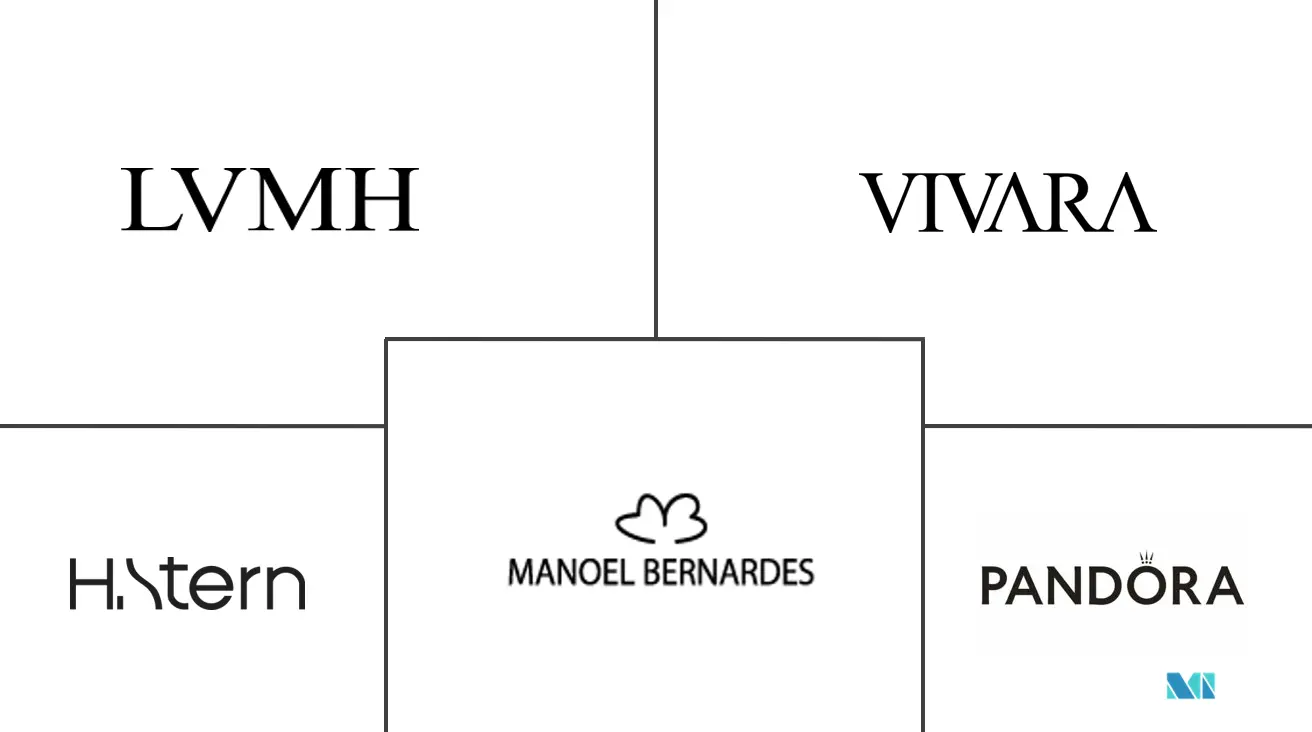Market Size of Latin America Jewelry Industry

| Study Period | 2019 - 2029 |
| Base Year For Estimation | 2023 |
| Forecast Data Period | 2024 - 2029 |
| Historical Data Period | 2019 - 2022 |
| CAGR | 2.79 % |
| Market Concentration | Low |
Major Players
*Disclaimer: Major Players sorted in no particular order |
Latin American Jewelry Market Analysis
The Latin American jewelry market is projected to witness a CAGR of 2.79% over the forecast period (2022-2027).
The Latin American jewelry market faced a decline in sales due to the influence of the COVID-19 pandemic. Government regulations, lockdowns, and shutdowns affected the sales, coupled with the decrease in demand for jewelry by customers. This was because people were restricted from going out, and the number of social gatherings and parties also decreased. But during the second quarter of the pandemic, people acknowledged the purchase of jewelry from online retail stores, increasing the demand for jewelry in Latin America further.
Jewelry sales in Latin America are mostly driven by fine jewelry, wherein Mexico and Brazil form the key markets for costume jewelry. The customers in the market prefer different varieties of fashion jewelry. On the other hand, the demand for precious stones like diamonds and gold is rising, creating an upsurge in the market demand. Moreover, the market studied is highly influenced by customers' changing lifestyles, who look for constant evolution in different designs and styles.
- Jewelry sales via offline stores hold a prominent share among the consumers, owing to the exclusive collections at these stores. However, in recent times, online retail stores are gaining traction, owing to the convenience and safety associated with shopping for jewelry online.
Latin American Jewelry Industry Segmentation
Jewelry refers to the personal ornaments of men and women, typically used to accessorize oneself. The Latin American jewelry market is segmented by category, type, distribution channel, and geography. Based on category, the market is segmented as real jewelry and costume jewelry. By type, the segmentation is done as necklaces, rings, earrings, charms & bracelets, and others. On the basis of distribution channels, the market is divided into offline retail and online retail stores. Further, the market is segmented by regions, such as Mexico, Brazil, Colombia, and the Rest of Latin America. For each segment, the market sizing and forecasts have been done on the basis of value (in USD million).
| By Category | |
| Real Jewelry | |
| Costume Jewelry |
| By Type | |
| Necklaces | |
| Rings | |
| Earrings | |
| Charms & Bracelets | |
| Others |
| By Distribution Channel | |
| Offline Retail Stores | |
| Online Retail Stores |
| Geography | |
| Brazil | |
| Mexico | |
| Colombia | |
| Rest of Latin America |
Latin America Jewelry Market Size Summary
The Latin American jewelry market is experiencing a gradual recovery and growth trajectory following the setbacks caused by the COVID-19 pandemic. Initially, the market faced challenges due to government-imposed restrictions and a decline in social gatherings, which reduced the demand for jewelry. However, the shift towards online retailing during the pandemic has significantly boosted demand, with consumers increasingly favoring the convenience and safety of e-commerce platforms. The market is characterized by a strong preference for fine jewelry, with Mexico and Brazil leading in the costume jewelry segment. The rising income levels and evolving fashion trends are further propelling the demand for fine jewelry, while the interest in precious stones like diamonds and gold is on the rise, reflecting the changing lifestyles and preferences of consumers.
The competitive landscape of the Latin American jewelry market is marked by the presence of both global and regional players, such as Jóias Vivara, Pandora SA, LVMH, Manoel Bernardes SA, and H Stern Jewelers Inc. These companies are focusing on product innovation and strategic expansions, including mergers and acquisitions, to enhance their market presence and cater to the evolving consumer demands. The market is becoming increasingly fragmented, with players leveraging strong distribution channels and digital innovations, such as virtual try-on features, to attract and retain customers. The emphasis on creating exclusive collections and collaborating with designers, as seen in initiatives like Muzo Emerald Colombia's collaboration with ten designers, highlights the industry's commitment to meeting the diverse tastes and preferences of Latin American consumers.
Latin America Jewelry Market Size - Table of Contents
-
1. MARKET DYNAMICS
-
1.1 Market Drivers
-
1.2 Market Restraints
-
1.3 Porter's Five Forces Analysis
-
1.3.1 Threat of New Entrants
-
1.3.2 Bargaining Power of Buyers/Consumers
-
1.3.3 Bargaining Power of Suppliers
-
1.3.4 Threat of Substitute Products
-
1.3.5 Intensity of Competitive Rivalry
-
-
-
2. MARKET SEGMENTATION
-
2.1 By Category
-
2.1.1 Real Jewelry
-
2.1.2 Costume Jewelry
-
-
2.2 By Type
-
2.2.1 Necklaces
-
2.2.2 Rings
-
2.2.3 Earrings
-
2.2.4 Charms & Bracelets
-
2.2.5 Others
-
-
2.3 By Distribution Channel
-
2.3.1 Offline Retail Stores
-
2.3.2 Online Retail Stores
-
-
2.4 Geography
-
2.4.1 Brazil
-
2.4.2 Mexico
-
2.4.3 Colombia
-
2.4.4 Rest of Latin America
-
-
Latin America Jewelry Market Size FAQs
What is the current Latin America Jewelry Market size?
The Latin America Jewelry Market is projected to register a CAGR of 2.79% during the forecast period (2024-2029)
Who are the key players in Latin America Jewelry Market?
Jóias Vivara, Pandora SA, LVMH, Manoel Bernardes SA and H Stern Jewelers Inc. are the major companies operating in the Latin America Jewelry Market.

